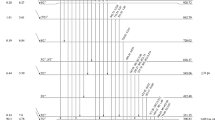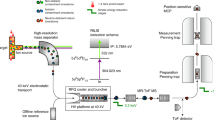Abstract
Nuclear physics is advancing rapidly at the precision frontier, where measurements of nuclear observables are challenging state-of-the-art nuclear models. A major contribution is associated with the increasing availability of accelerated beams of radioactive ions produced using the isotope separation on-line technique. These advances have come hand in hand with significant progress in the development of high-efficiency detector systems and improved target technologies which are invaluable in exploiting these beams to their full advantage. This article reviews some of the recent highlights in the field of nuclear structure profiting from these technological advances.
This is a preview of subscription content, access via your institution
Access options
Subscribe to this journal
Receive 12 print issues and online access
$209.00 per year
only $17.42 per issue
Buy this article
- Purchase on Springer Link
- Instant access to full article PDF
Prices may be subject to local taxes which are calculated during checkout


Similar content being viewed by others
References
Wiescher, M., Käppeler, F. & Langanke, K. Critical reactions in contemporary nuclear astrophysics. Annu. Rev. Astron. Astrophys. 50, 165–210 (2012).
Schatz, H. et al. rp-process nucleosynthesis at extreme temperature and density conditions. Phys. Rep. 294, 167–263 (1998).
Epelbaum, E., Krebs, H., Lee, D. & Meissner, U-G. Ab initio calculation of the Hoyle state. Phys. Rev. Lett. 106, 192501 (2011).
Bohr, Aa. & Mottelson, B. R. Nuclear Structure. Volume 1: Single-particle Models (World Scientific, 1998).
Bohr, Aa. & Mottelson, B. R. Nuclear Structure. Volume 2: Nuclear Deformation (World Scientific, 1998).
Rowe, D. J. & Wood, J. L. Fundamentals of Nuclear Models (World Scientific, 2010).
Erler, J. et al. The limits of the nuclear landscape. Nature 486, 509–512 (2012).
Carroll, R. J. et al. Blurring the boundaries: Decays of multiparticle isomers at the proton drip line. Phys. Rev. Lett. 112, 092501 (2014).
Hansen, P. G. in The SC: ISOLDE and Nuclear Structure Vol. 3 (ed. Krige, J.) 327–413 (North Holland, 1997).
Huyse, M. & Raabe, R. Radioactive ion beam physics at the Cyclotron Research Centre Louvain-la-Neuve. J. Phys. G 38, 024001 (2011).
Fedosseev, V. N., Kurdyravtsev, Yu. & Mishin, V. I. Resonance laser ionization of atoms for nuclear physics. Phys. Scr. 85, 058104 (2012).
Rothe, S. et al. Measurement of the first ionization potential of astatine by laser ionization spectroscopy. Nature Commun. 4, 1835 (2013).
Benlliure, J. Recent highlights on fragmentation reactions. J. Phys. Conf. Ser. 312, 082001 (2011).
Schwarz, S. et al. The NSCL cyclotron gas stopper—under construction. Nucl. Instrum. Methods B 317, 464–466 (2013).
Navin, A., de Oliviera Santos, F., Roussel-Chomaz, P. & Sorlin, O. Nuclear structure and reaction studies at SPIRAL. J. Phys. G 38, 024004 (2011).
Ball, G. C. et al. Physics with reaccelerated radioactive beams at TRIUMF-ISAC. J. Phys. G 38, 024003 (2011).
Habs, D. et al. The REX-ISOLDE project. Hyperfine Interact. 129, 43–66 (2000).
Van Duppen, P. & Riisager, K. Physics with REX-ISOLDE: From experiment to facility. J. Phys. G 38, 024005 (2011).
Göppert Mayer, M. Nuclear configurations in the spin-orbit coupling model. I. Empirical evidence. Phys. Rev. 78, 16–21 (1950).
Möller, P., Nix, J. R., Myers, W. D. & Swiatecki, W. J. Nuclear ground-state masses and deformations. At. Data Nucl. Data Tables 59, 185–381 (1995).
Takahara, S., Tajima, N. & Shimizu, Y. R. Nuclear prolate-shape dominance with the Woods–Saxon potential. Phys. Rev. C 86, 064323 (2012).
Stránský, P., Frank, A. & Bijker, R. On prolate shape dominance in nuclear deformation. J. Phys. Conf. Ser. 322, 012018 (2011).
Heyde, K. & Wood, J. L. Shape coexistence in atomic nuclei. Rev. Mod. Phys. 83, 1467–1521 (2011).
Bender, M., Bonche, P. & Heenen, P-H. Shape coexistence in neutron-deficient Kr isotopes: Constraints on the single-particle spectrum of self-consistent mean-field models from collective excitations. Phys. Rev. C 74, 024312 (2006).
Andreyev, A. N. et al. A triplet of differently shaped spin-zero states in the atomic nucleus 186Pb. Nature 405, 430–433 (2000).
Cheal, B. & Flanagan, K. T. Progress in laser spectroscopy at radioactive beam facilities. J. Phys. G 37, 113101 (2010).
Cocolios, T. E. et al. Early onset of ground state deformation in neutron deficient polonium isotopes. Phys. Rev. Lett. 106, 052503 (2011).
Gaffney, L. P. et al. Shape coexistence in neutron-deficient Hg isotopes studied via lifetime measurements in 184,186Hg and two-state mixing calculations. Phys. Rev. C 89, 024307 (2014).
Alder, K., Bohr, A., Huus, T., Mottelson, B. & Winther, A. Study of nuclear structure by electromagnetic excitation with accelerated ions. Rev. Mod. Phys. 28, 432–542 (1956).
Häusser, O. et al. Coulomb excitation of 28Si projectiles. Phys. Rev. Lett. 23, 320–323 (1969).
Clement, E. et al. Shape coexistence in neutron-deficient krypton isotopes. Phys. Rev. C 75, 054313 (2007).
Yao, J. M., Hagino, K., Li, Z. P., Meng, J. & Ring, P. Microscopic benchmark study of triaxiality in low-lying states of 76Kr. Phys. Rev. C 89, 054306 (2014).
Hurst, A. M. et al. Measurement of the sign of the spectroscopic quadrupole moment for the 21+ state in 70Se: No evidence for oblate shape. Phys. Rev. Lett. 98, 072501 (2007).
Ljungvall, J. et al. Shape coexistence in light Se isotopes: Evidence for oblate shapes. Phys. Rev. Lett. 100, 102502 (2008).
Bree, N. et al. Shape coexistence in the neutron-deficient even-even 182−188Hg isotopes studied via Coulomb excitation. Phys. Rev. Lett. 112, 162701 (2014).
Butler, P. A. & Nazarewicz, W. Intrinsic reflection asymmetry in atomic nuclei. Rev. Mod. Phys. 68, 349–421 (1996).
Dobaczewski, J. & Engel, J. Nuclear time-reversal violation and the Schiff moment of 225Ra. Phys. Rev. Lett. 94, 232502 (2005).
Gaffney, L. P. et al. Studies of pear-shaped nuclei using accelerated radioactive beams. Nature 497, 199–204 (2013).
Savajols, H. et al. VAMOS: A variable mode high acceptance spectrometer for identifying reaction products induced by SPIRAL beams. Nucl. Instrum. Methods B 204, 146–153 (2003).
Davids, B. S. & Davids, C. N. EMMA: A recoil mass spectrometer for ISAC-II at TRIUMF. Nucl. Instrum. Methods A 544, 565–576 (2005).
Hinke, C. B. et al. Superallowed Gamow-Teller decay of the doubly magic nucleus 100Sn. Nature 486, 341–345 (2012).
Jones, K. L. et al. The magic nature of 132Sn explored through the single-particle states of 133Sn. Nature 465, 454–457 (2010).
Pain, S. D. et al. Development of a high solid-angle silicon detector array for measurement of transfer reactions in inverse kinematics. Nucl. Instrum. Methods B 261, 1122–1127 (2007).
Diget, C. A. et al. SHARC: Silicon highly-segmented array for reactions and Coulex used in conjunction with the TIGRESS γ-ray spectrometer. J. Instrum. 6, P02005 (2011).
Bildstein, V. et al. T-REX. Eur. Phys. J. A 48, 85 (2012).
Warr, N. et al. The MINIBALL spectrometer. Eur. Phys. J. A 49, 40 (2013).
Wuosmaa, A. H. et al. A solenoidal spectrometer for reactions in inverse kinematics. Nucl. Instrum. Methods A 580, 1290–1300 (2007).
Lighthall, J. C. et al. Commissioning of the HELIOS spectrometer. Nucl. Instrum. Methods A 622, 97–106 (2010).
Herlert, A. & Kadi, Y. The HIE-ISOLDE Project. J. Phys. Conf. Ser. 312, 052010 (2010).
Grieser, M. et al. Storage ring at HIE-ISOLDE. Eur. Phys. J. 207, 1–117 (2012).
Acknowledgements
Discussions with L. Gaffney are gratefully acknowledged. E. Power is thanked for producing the figures. P. Davies, D. Gilks, J. Henderson and D. Montanari are thanked for their careful reading of the manuscript. W. Power is thanked for her advice on formatting the text for a non-specialist reader.
Author information
Authors and Affiliations
Corresponding author
Ethics declarations
Competing interests
The author declares no competing financial interests.
Rights and permissions
About this article
Cite this article
Jenkins, D. Recent advances in nuclear physics through on-line isotope separation. Nature Phys 10, 909–913 (2014). https://doi.org/10.1038/nphys3165
Received:
Accepted:
Published:
Issue Date:
DOI: https://doi.org/10.1038/nphys3165



